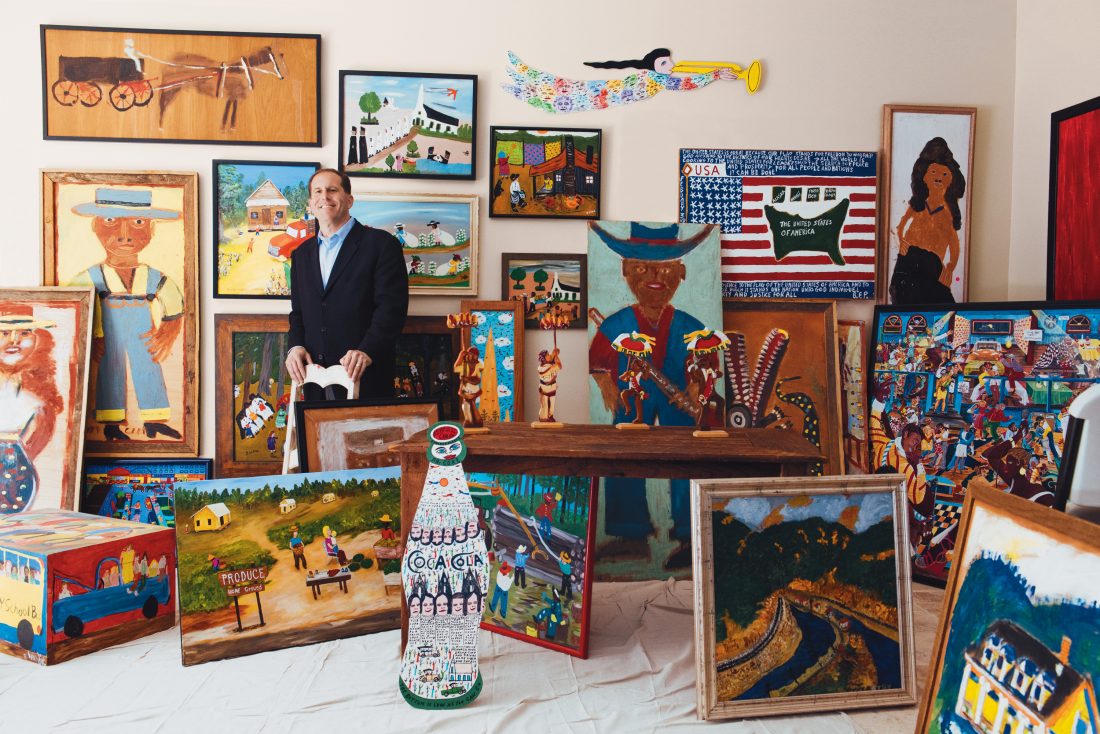Doug Gitter was fresh out of the University of Texas in Austin when he first met Bernice Sims. It was the mid-eighties, and Gitter’s father, who collected art, thought her work might strike a chord with him. These were the days before GPS, and Doug had never heard of Brewton, Alabama. But he drove until he came to the small town not far from the Florida border, and asked a woman coming out of church where he could find Bernice Sims. She, like everybody in Brewton, knew where Sims lived.
Gitter is forty-nine now, years as a financial adviser under his belt, living just outside of New Orleans in a stately redbrick home with his wife and two children. His house is filled well beyond capacity with hundreds of pieces of folk art from across the South. But he still points back to that meeting with Bernice Sims as a moment when things changed for him. He found himself transfixed by her and her work—an emotional documentary of her experience in the rural South, done in bold colors and soft shapes. Many subjects go beyond the bucolic. Sims grew up in the segregated South, marched in Selma, and only started painting in her fifties. One of her most famous pieces, 1965 Selma March, recounts the events she witnessed.

Photo: Rush Jagoe
Gitter with Ghetto Life, by Purvis Young.
“I became good friends with her,” Gitter recalls. “I remember one time, when I broke up with a girlfriend and I was all down and out, I drove to talk to Bernice. That’s what it was with all these artists. It wasn’t like I collected their work and they were done with me. They were like family.”
Sims must have seen something in Gitter, too. After that initial meeting, she sent him to check out Woodie Long, a housepainter who found himself more entertained by doodling on the sides of buildings than by covering them in any one color. Back up the road, she told him, then onto the highway, about forty-five minutes until you get off at Andalusia, then right down the dirt road by the white church and about a quarter mile until you see a mailbox with “Woodie” on it. He went, and with that he became an art collector.
“It was like a treasure hunt, because you never knew what you were going to find,” Gitter says. “I could go visit with these folks, learn about their lives, learn about them, their families, their dog, their background, why they paint what they paint. It was amazing to me.”
Today, even Gitter’s closets are stacked high with wrapped frames. He finds himself fighting with his wife, Cathy, over every inch of wall space: Surely, she figures, there must be room for something besides Southern folk art on at least a single wall of the house. He disagrees.
You don’t see a lot of typical canvases there: The painters Gitter collects used what they had, and so his walls are covered with a haphazard collection of boards, palettes, doors, and shutters, all in bright colors thick with texture. There are rural scenes, sermons painted on window frames, wooden cutouts of New Orleans brass bands. For the most part, he bought from the artists themselves, spending his early adulthood driving between small towns scattered from Georgia to New Mexico to find pieces, painters, and their stories. One of his favorite painters is Jimmy Lee Sudduth, famous for a homemade pigment he called “sweet mud”: a mixture of house paint, Dr Pepper, Alabama clay, coffee, plants, sand, sugar, honey, and whatever else. Gitter met him for the first time at his house in Fayette, Alabama, surrounded by boards and buckets of sweet mud, his dog, Toto, at his side.
“Shut my mouth!” Gitter remembers him saying when they met, his eyes lighting up as his relaxed Louisiana drawl shifts into an imitation of Sudduth’s Alabama accent. “I’m gonna be famous!” He was already well known at the time; by the end of his life, Sudduth had been written up in the New York Times and the Boston Herald, with people coming to Alabama from all over the world to see his work.

Photo: Rush Jagoe
gg0315_collections_03
A plate depicting Zinnias, by Clementine Hunter.
Even though folk art caught fire in the international art world, Gitter recognizes that the work is essentially populist—and he wants to keep it accessible. He has donated dozens of items from his collection to hospitals in Louisiana, Alabama, and Florida. He also partners with the estates of several of the artists he has collected to make reproductions of their pieces. His best-known collaboration is with the estate of Clementine Hunter, whose art he has collected since the 1980s. A portion of the proceeds from sales of the ceramics collection that now bears Hunter’s name helps maintain her home at Louisiana’s Melrose Plantation, a National Historic Landmark.
“With the money we’ve generated, we’re finally able to start restoring her house,” says Thomas Whitehead, a longtime friend of Hunter’s and the executor of her will. “We’ve never had any income before.”
As Gitter sees it, this art was always meant to be shared and enjoyed. “When Clementine Hunter was living,” he says, moving his fingers over the relief of one of her bowls, “you could actually go up to Melrose Plantation, go up to Natchitoches, go talk to her, and buy a painting for a few dollars. Nowadays, that same painting might sell for several thousands of dollars.
“These people, they really just cared,” he adds, remembering Bernice Sims, to whom he remained close until she died last year. “And I think that’s why I’m so passionate about their work. It’s from the heart.”








